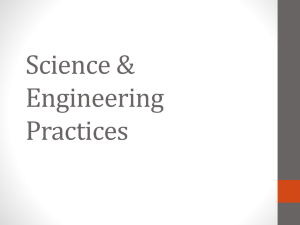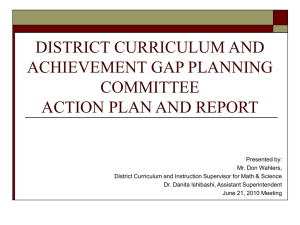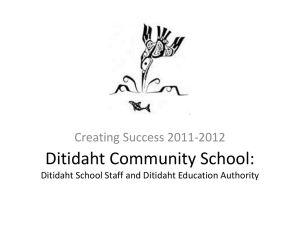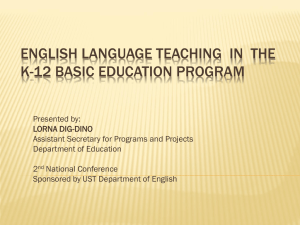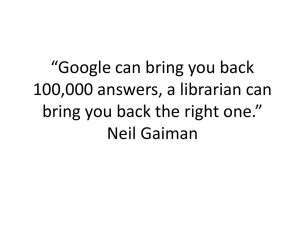selling strategies in k-12–your to-do`s on monday
advertisement
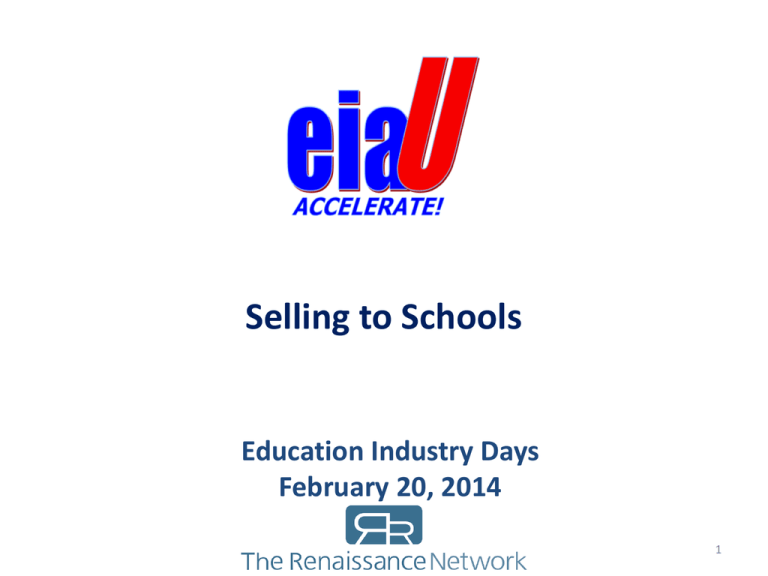
Selling to Schools Education Industry Days February 20, 2014 1 INTRODUCTION 2 Session Summary • This session will help participants understand the ins and outs of selling into the K-12 Education market. • The session will be oriented toward: – New/emerging entrepreneurs in the early stages of their company’s development – New education sales executives looking to gain more knowledge of how to successfully sell to K-12 customers. 3 • Introduction Session Overview – Summary of session – Learning objectives • Overview of the landscape of K-12 – Key initiatives in K-12 • Building a Sales Strategy – Average Deal Size – K-12 Sales Cycle – Buying Seasons – Decision-makers • Sales Models and Sales Team Structure – Direct, Indirect/Channel, Independent Sales Models – Inside, Outside/Field, Hybrid Sales Team Structures 4 • Sales Metrics Session Overview – What are metrics – Metrics by example • Selling: The Details – 2 Keys to Successfully Sell into Schools – Identifying Your Decision-Makers – ROI for Education – Articulating Your Value Proposition – Feature Selling vs. Solution Selling – Using Funding • What to Look for When Hiring K-12 Sales Talent – What are the key traits to look for in K-12 Sales Talent – How to uncover if your candidate has these traits • Group Activity and Take Home Activity • Wrap Up 5 Learning Objectives • By the end of this session, participants will learn: – What types of sales strategies, sales models, and sales team structures exist in the K-12 and what to consider when building your sales plan. – How to build sales metrics to measure your performance. – How to identify your K-12 decision-makers and articulate your value proposition in order to close sales. – How to use funding to sell. – What to look for when hiring Education sales talent. 6 The Renaissance Network • Focused on building sales, marketing, and leadership teams for Education and Technology companies over 17 years. • We act as a trusted advisor for the US Education market to help our clients build an effective sales and hiring strategy to penetrate the market. 7 Some of Our Partnerships 8 K-12 EDUCATION MARKET: AN OVERVIEW 9 Why is there an Education Market? In order to understand how to sell into the K-12 Education market, we must first understand why the market exists. • How do I know I am receiving the best education? • How do I know my children are being adequately educated? • How do I know if my teachers are teaching in the best way for their students? To successfully sell into the education space, we have to ensure that these questions are being answered! 10 US K-12 Students and Teachers 50.1M public students 5.2M private school students 55.3M elementary and secondary students Taught by 3.3M elementary and secondary teachers 11 US Education Market Quick Facts Federal State Local $591 Billion in K-12 Spending 12 Key Growth Directed Sub-Markets ESL/ELL STEM Early Childhood Career Readiness College Readiness Assessment Special Education PD 13 Technology, Technology, Technology • Technology is at the core of many school initiatives including: – Hardware – Software – Online teacher training – Wireless infrastructure • 75% of districts report stable or increasing technology budgets for the 2013-2014 school year 14 Common Core • With 46 states + DC adopting CCSS, a majority of districts will drive towards purchasing new materials or products to help facilitate shifts to a standards-based education model. – 68% of districts plan to purchase new products for the 2014-2015 school year, a product of this shift. 15 BUILDING YOUR SALES STRATEGY 16 Your Sales Strategy is Fundamental to Your Company’s Success • Having the right sales strategy in place is fundamental to: –Revenue growth –Impacting student achievement 17 Your Sales Strategy is Fundamental to Your Company’s Success • It’s a disruptive, relatively new market with a ton of competition… –Your sales team must be able: • Capture market share from the competition • Bring on net new customers and retain business 18 Average K-12 Deal Size • The average Deal Size, or average dollar amount, in K-12 can range from a few hundred dollars to millions of dollars. –Largely dependent on price point and pricing structure. 19 How Your Deal Size Impacts Your Sale • The amount of $ your product typically will impact: – Who to sell to – When to sell – Complete sales process • Some States trigger an RFP for product needs which will result in a sale over a specific $ amount • Typically proposals must be in during the Spring 20 K-12 Sales Cycle • The Sales Cycle is largely dependent upon the deal size of your products and the products themselves. –The larger and more complex the deal, the longer the sales cycle. –Range: 2 weeks to 2 years (for major initiatives) –Typical: 6-9 months 21 Typical Buying Seasons in K-12 • The Buying Season is largely dependent upon the school calendar year and your product. – Needs Assessment: Spring through mid-Fall – Purchasing Decisions: Fall through Spring • For more complex sales, you typically start 9+ months out • Sales activities must be completed all year 22 Key Decision-makers in K-12 Federal State Federal Purchase for all (or some) States, Districts, and Schools by Federal Department of Education State Purchase for all Districts and Schools by State Department of Education District District-wide (a conglomerate of 2 or more schools within a region) by a superintendent, chief technology officer, chief curriculum officer, school board School Individual School purchase by a principal, head of curriculum, PD coach Classroom Individual classroom purchase by a teacher 23 Piloting Your Product: What Start-ups Should Know • Launch test cases with pilot programs at least a year out of driving sales – Collect “success data” to use as testimonial evidence when officially selling your product • Free pilots can be a double-edged sword: – Many districts won’t want to buy what they had before for free 24 SALES MODELS AND SALES TEAM STRUCTURE 25 Sales Models and Structure When considering building a sales team, your: –deal size, –sales cycle, –and your decision makers all factor into the sales model and the sales team structure you will need to be successful. 26 Sales Models: Direct Sales • Employees of your company • Compensation: base salary + commissions – Base salary: roughly 60% of total earnings – Commissions: 40% of total earnings, often based on quota attainment • Ideally uncapped to reward for overperformance • Percentages paid on revenue can vary 27 Sales Models: Indirect or Channel Sales • Selling through a dealer/reseller partnership – Dealer will have a team of sales executives – You may need a channel manager who is an employee of your organization to manage the partnership – Many products will be represented by the dealer • Compensation (paid by dealer): – Base salary: 70-75% of total earnings – Commissions: typically flat $ amounts based on concrete goals 28 Sales Models: Independent Sales Representatives • Individuals who represent multiple organizations and products without being employed by any particular organization • Compensation: – Base Salary: none – Commissions: 100% of a rep’s income 29 Comparing Sales Models Direct • Can closely monitor activity levels • Can closely control over how products are represented • Can quickly address challenges and underperformance • Costs more Channel • Larger sales footprint • May have costs of channel manager • No guarantee of success • Channel may sell competing products Independent • No upfront costs • Need strong training and internal support for success • May sell competing products • No guarantee of success * You can build a hybrid sales model. 30 Sales Team Structure: Inside Sales Teams • One or more individuals will sell your product(s) over the phone, email, video conference, and webinar from your headquarters. –Typically most effective for selling smaller price-point deals which are less complex and do not require consultation face-to-face. 31 Sales Team Structure: Outside or Field Sales Teams • One or more individuals who travel to their customers to sell. • Typically, field sales representatives will work out of a home office and live within their assigned territory. 32 Sales Team Structure: Hybrid Inside and Outside Team • Inside team: responsible for smaller deals, lead generation of large deals to the field team, and account management. • Field team: works closely with an inside sales representative on larger, more complex deals which require face-to-face consultation 33 SALES METRICS 34 Sales Metrics • A collection of individual and organizational performance indicators which allow you to break down what (and how many) sales activities are necessary to meet your yearly revenue goals. 35 Creating Your Own Sales Metrics • Based on your annual financial goal, you can determine what activities (phone calls, meetings, proposals) must be performed to meet your goals. 36 Sales Metrics: Example STEP 1 What is your annual financial goal? $700,000 Step 2 Divide by 4 to get your quarterly goal $175,000 Divide by 12 go get your monthly goal $58.333.33 STEP 3 What is your AVERAGE DEAL SIZE? $4,000 STEP 4 Determine the number of OPPORTUNITIES you need to CLOSE to achieve your monthly goals. 15 STEP 5 What is your CLOSING RATIO as a percent of PROPOSALS SUBMITTED? 35% STEP 6 How many PROPOSALS do you need to submit to close one deal? 3 STEP 7 How many meetings does it take to generate one proposal? 2 How many meetings does it take in order to achieve your ideal number of PROPOSALS? 83 How many PHONE CALLS does it take to generate one MEETINGS? 10 How many PHONE CALLS do you need to have in order to achieve your ideal number of MEETINGS? 833 STEP 8 37 SALES PROCESS 38 A Long and Arduous Process • Selling into schools can be a long and frustrating process. – Why? • Because you are asking teachers, administrators, and students to change habits and alter their past method of performance– this can cause great stress on an organization • To have your product purchased and implemented, you need buy in from many decision-makers. 39 2 Keys to Successfully Sell into Schools • Your company’s ability to build and leverage customer relationships. • Your company’s ability to articulate your value proposition in terms of student, teacher, or school success. 40 Building Relationships: Identifying Your Decision-maker • To build and leverage the right relationships you must identify your key decision-makers: – These will be both the person who will sign your contract and the end users of your products. – Therefore you must sell both from the top down and the bottom up. 41 Every Cause Needs a Champion • Usually your product’s champion will be a respected teacher/administrator who will motivate others to buy into your product’s use • Once you sell, use your product’s champion (either a teacher or a higher-level official), for testimonial evidence to help you sell. 42 THERE IS NO “ROI” in K-12 • ROI is vastly different in the Education space in comparison to other industries. • In fact, using ROI terminology may turn off your K-12 Customer. 43 What is the K-12 Equivalent of ROI? • K-12 decision-makers are reluctant to invest in products unless: – They believe the product will have a clear, positive impact on the classroom – They believe the product will increase student achievement – They believe the product will provide relief to teachers which will positively impact student performance 44 Articulating Your Value Proposition • Your ability to articulate your value proposition (why your customer should chose your product) in terms of student, teacher, or school success is fundamental to close a sale. 45 Feature Selling vs. Solution Selling • Don’t sell technology and its functions – Schools don’t exist for the purpose of using technology • Don’t sell the table of contents of your textbook – Instead, point to clear positive solutions teaching your content can provide 46 Solution Selling: A How To • Know the landscape of your customer’s school very specifically – What is its mission? – What are its key initiatives? – What are the biggest challenges? • Ask your customer consultative questions to uncover your customer’s struggles before you mention your product. • Then align your product to a concrete solution which you can offer your customer based on the specific challenges or initiatives in the school. – Point to the positive outcomes that your product provides. 47 If price point is an objection, point to funding! • There is a growing trend that funding (both at federal and state level) is used for specific initiatives in school. • Know what funding your customer has, what it must be used for, and align your product to the funding. 48 WHAT TO LOOK FOR WHEN HIRING K-12 SALES TALENT 49 What to look for when you are hiring for K-12 Sales Talent • Experience selling into K-12 (rather than HiEd or other markets) • Experience selling similar deal sizes to yours • Experience selling within a similar sales cycle to yours • Key contacts and decision makers which are the same as yours • Knowledge of funding opportunities • Knowledge of key initiatives within schools in his/her territory • A solution selling approach vs. feature sales approach 50 Additional Hiring Tips • If you have an open or underperforming territory, don’t wait to fix it! – Lost sales and lost pipeline will set you back. • When you start to hire, move quickly and efficiently- the shorter your timeline to hire the shorter your timeline to sales impact. • Don’t always hire from within your own network – The top candidate is the one selling to your customers for someone else. • Have a structured hiring and interview process – Use behavioral-based interview questions specific to K-12 – Use a customized sales assessment 51 GROUP ACTIVITY 52 Value Proposition Mad Libs For (target K-12 customer), who has (customer need) , (product name) is a (market category) that (one key benefit) that can cause (student/administrator/educator outcome). 53 Articulating Your Value Proposition • Form groups of four to six (4-6). • Within your group, nominate a sales person to target and pitch his/her value proposition mad lib to a series of key customers. • The other members of the group will choose from the following roles: – – – – – Teacher Administrator, Chief Technology officer Curriculum Director Principal/Superintendent • The sales person must ask appropriate questions to their group members to uncover what are the key issues for each decision-maker. • The sales person must then pitch their product as it relates to the decision maker they are targeting customizing their mad lib. • As a group, develop the core objections for the product being pitched; work with the sales person to rebut objections. 54 Wrapping Up – Building the right sales strategy is fundamental to your success; choose the sales model and team structure that will align to your growth goals. – Sales Metrics: build them specifically so they align to your revenue goals – Target the appropriate decision-maker for your product and use product champions to help you get through the door. – Align key funding or other initiatives to successfully close sales. – Sell solutions not products: schools don’t exist for your product; they exist to provide strong education and your products must be a solution to the core challenges which impact education. – When building your sales team, make sure you uncover the right type of sales talent for your needs. 55 Q&A Contact Information: Lisa Sacchetti, CEO The Renaissance Network, Inc. Sales Team Expansion Specialists for Education and Technology lisas@ren-network.com 617-796-9210 www.ren-network.com 56

